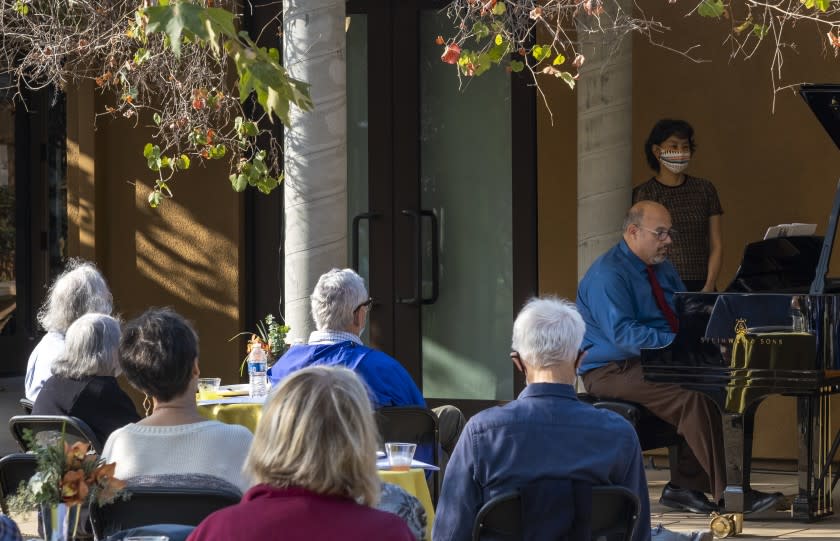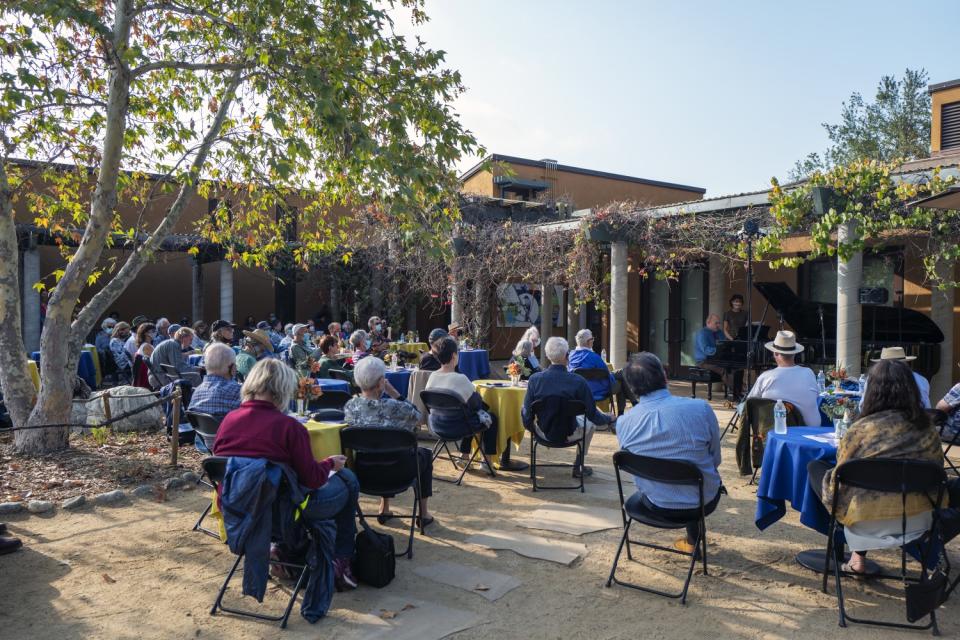Review: The crazy genius of playing Messiaen's 13 bird-inspired piano solos at L.A.'s Audubon Center

- Oops!Something went wrong.Please try again later.
Like most arts groups, Piano Spheres got through a performance-free pandemic the best it could on Zoom. But after the initial video-vérité fascination of peeking into pianists’ living or practice rooms, a Zoom gloom set in as online recitals, be they amateur or professional, proliferated from seemingly everywhere.
What’s the alternative? Sensitive pianos don’t like the great outdoors, that’s for the birds. So be it. The ever-venturesome piano series' rowdy return to live concerts Sunday afternoon happened to be at — where else? — Audubon Center at Debs Park, a stopover point, just off our Pasadena Freeway, for migratory birds on their Pacific Flyway.
A 9-foot, broad-beaked black Steinway grand landed on the center’s patio. The occasion was a rare complete performance of Messiaen’s obsessive “Catalogue d’Oiseaux,” 13 arresting virtuosic solo pieces suffused with the calls of dozens of birds that the composer heard while birding in the French countryside during the mid-1950s.
Tables and folding chairs were set up on the lawn, with its lovely pond in the rear. Birds were in the minority, for the most part gracefully gliding over a distant hill likely out of range for the sensitively amplified piano. One let out an occasional squawk.
Although single-minded birder pianists with technique to burn (an extremely small species) do attempt the complete manic “Catalogue,” which lasts close to three hours in performance, Piano Spheres realistically split the duties among 13 soloists. That included the series' core artists Vicki Ray, Mark Robson, Thomas Kotcheff and Sarah Gibson, along with guest pianists, well-known and newcomers.
A description of Messiaen’s “Catalogue” makes it sound crazy, which, of course, it is. Each of the movements — they range from about five to 30 minutes — is named for a specific bird, but many other kinds make their noisy appearances as secondary characters. The ever-clattering keyboard attempts to mimic their myriad chirps, this way and that, producing a startling, exhausting, headache-making, metallic-sounding menagerie that never seems to end and makes zero sense to anyone without wings.
But that is also the genius of Messiaen’s piano writing. There was no end to his versatility in turning birdsong into piano song. The evocations come across not as translations of one kind of sound into another but as hearing birds speak in astonishing piano accents.
The composer is less documentarian than poet. He places his birds on cliffs, at river banks, in punishing arid sunshine and moldy forest darkness. Some movements are about the birds and their interactions. Some are about the passage of time. The huge central movement, the one that can last over a half-hour, represents 27 hours in the life of the reed warbler.
Messiaen provided florid descriptions of the movements, and in this one the reed warbler is the great orator of his local lily pond. Frogs croak, a skylark soars above all in dazzling pianistic glitter, grasshopper warblers rattle as their names suggest, and one reed warbler enters into a rapturous contrapuntal duet with another.
These elaborately evocative settings are precisely what makes us notice the birds. The ninth movement, for instance, is devoted to Cetti’s warbler, a cute little brown bird with a violent call, yet one incapable of breaking the spell of a small tributary that is heard flowing with such rich harmonies that it may be the river of love. All that is winged, even the grating corn crake, is painted with a mystical birder's unworldly rose-colored pianistic glasses. All Messiaen's birds are angels.

The 13 pianists brought their own levels of avian awareness. Genevieve Feiwen Lee (Alpine chough), Nelson Ojeda Valdés (blue rock thrush), Joanne Pearce Martin (rock thrush) and Nadia Shpachenko (curlew) played as though peering through binoculars, mapping birds, marveling from afar with an ornithologist’s objectivity. Ray (golden oriole), Aron Kallay (tawny owl) and Gibson (buzzard) approached the birds close up, highlighting their colors and revealing luxuriant emotions aroused by the atmospheric settings.
Kotcheff (black-eared wheatear), Steven Vanhauwaert (woodlark), Danny Holt (short-toed lark) and David Kaplan (black wheatear) trusted their magnificent pianism to bring birds vividly to life. In a fast and furious performance, Yevgeniy Milyavskiy was the extreme example of this, bringing a massive sound to the reed warbler's massive world.
In a class of his own was Mark Robson (Cetti’s warbler). His was one of the more modest (everything is relevant when it comes to Messiaen and birds) movements, but he was clearly the key figure in the whole project. He had studied in Paris with Messiaen’s wife, Yvonne Loriod, for whom the “Catalogue” was written. He is one of the most illuminating (if the least known) of today’s Messiaen pianists.
He gave every bird in an extravagant menagerie a rapt individuality. You knew the blackcap by the piano improbably impersonating a flute. Messiaen wanted the hoopoe to create the effect of a harpsichord mixed with a gong, and that’s what it was. Beyond all that, Robson, in his mere dozen minutes at the keyboard, imbued an entire bird-besotted afternoon with a pervasive mood of aviary wonderment.
This story originally appeared in Los Angeles Times.

